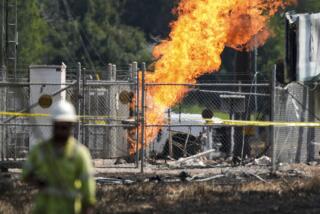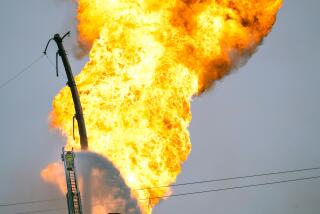8,000 Miles of Pipelines Cross State
The 14-inch pipeline that ruptured and set off a deadly fire in a San Bernardino neighborhood Thursday is part of 8,000 miles of pipeline that carry oil, gasoline and other hazardous liquids under many residential communities throughout the state.
One major line, for instance, bisects Orange County from Buena Park to San Clemente, although it mostly avoids residential areas, officials said.
âWe would not look very favorably on constructing pipelines through a residential area, but to get to the refineries, you have to go through those areas,â said Thomas Lael, associate pipeline safety engineer in the state fire marshalâs office. âYou are between a rock and a hard place.â
The largest concentration of these lines is under the Los Angeles Basin, and many, possibly most, run near or under residential communities, Lael said. Each month, there are 15 to 20 leaks or pipeline spills statewide, ranging from a few ounces of fuel to 1,000 barrels.
âI donât want to make it sound routine, but with that many miles of pipeline, this (a spill or leak) is just a normal occurrenceâ caused by pipe corrosion, he said. âMost of them are real small leaks anyway, a quart or a gallon or a pint.â
Explosions are rare.
âWith 99% of the spills, there is no fire or ignition,â Lael said . âThis (the San Bernardino blaze) is the exception. You need to have a source of ignition, like a vehicle with an engine running or a cigarette.â
Orange County Spill
Neal Osborne, a San Bernardino County planning analyst, said the houses that burned Thursday were built in the early 1970s, a time when the proximity of a pipeline probably would not have been considered and no environmental impact report was required.
âThere wouldnât have been any environmental determination made,â he said.
In Orange County, Thursdayâs explosion brought to mind the 1986 pipeline rupture that spewed 500,000 gallons of unleaded gasoline into a flood control channel adjacent to the Tustin Marine Corps Helicopter Air Station.
âItâs amazing there wasnât an explosion then,â said Robert Collacott, manager of Orange Countyâs environmental resources division. âAll it would have taken would have been a spark.â
That rupture occurred along the countyâs main pipeline, a 40-mile-long common carrier for most Southern California oil companies that is operated by the San Diego Pipeline Co. The oil companies pay a fee for using the pipeline, which is 16 inches wide and propels liquids using pressure of up to 1,600 pounds per square inch, Collacott said.
The San Diego Pipeline Co. line roughly parallels the Santa Ana Freeway through Orange County.
Most of the pipelines in Orange County carry less volatile crude oil, said Ed Ferrer, a construction engineer and a specialist in pipeline construction. âMost of them run from the Huntington Beach area to the refinery districts in L.A. County,â Ferrer said.
The pipeline that caused the San Bernardino explosion transports 80,000 barrels of gasoline 250 miles each day from Colton to Las Vegas. It is owned by Calnev Pipe Line Co., a common carrier that state officials characterize as âcooperative.â
The company âhas a good safety record,â said James Wait, acting manager of the pipeline safety program for the state fire marshal.
It was Waitâs office that gave the pipeline a clean bill on May 16, the last inspection after the May 12 train derailment. âEverything looked fine to us and to the operators,â Wait said.
After the train wreck, his office had engineers on the site each day during the cleanup âmaking sure we did everything we could to avoid a puncture or an accident.â
âWe thought that process was finished and we had succeeded. . . .â he said. âItâs just a mystery at this point.â
The fire marshal works with the U.S. Department of Transportation to enforce pipeline safety laws. Usually, the fire marshal inspects a pipeline every year or 18 months to ensure that the carriers meet all federal requirements, including regular patrol of the pipeline to search for leaks and maintenance of valves.
âI donât recall any particular difficulty with (Calnev) as far as complying with our regulations,â Lael said.
In California, real estate brokers are required to disclose the existence of a gasoline line to buyers only if it is on the property, not just nearby, said George Hartwell, spokesman for the state Department of Real Estate. Subdivisions have more extensive disclosure requirements, and the presence of a nearby gasoline pipeline would have to be reported.
Residents of the area devastated by Thursdayâs blast said they were unaware of the gasoline line that skirted their neighborhood until its existence became known after the train wreck two weeks ago.
Times staff writers Daryl Kelley and Paul Jacobs contributed to this story.
More to Read
Sign up for Essential California
The most important California stories and recommendations in your inbox every morning.
You may occasionally receive promotional content from the Los Angeles Times.











